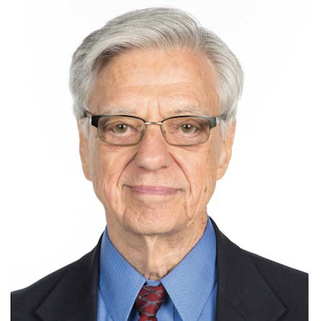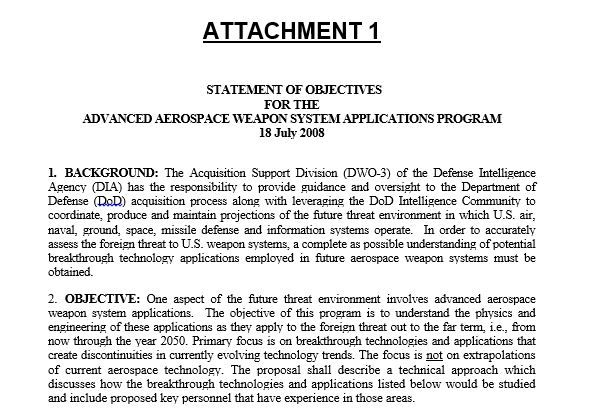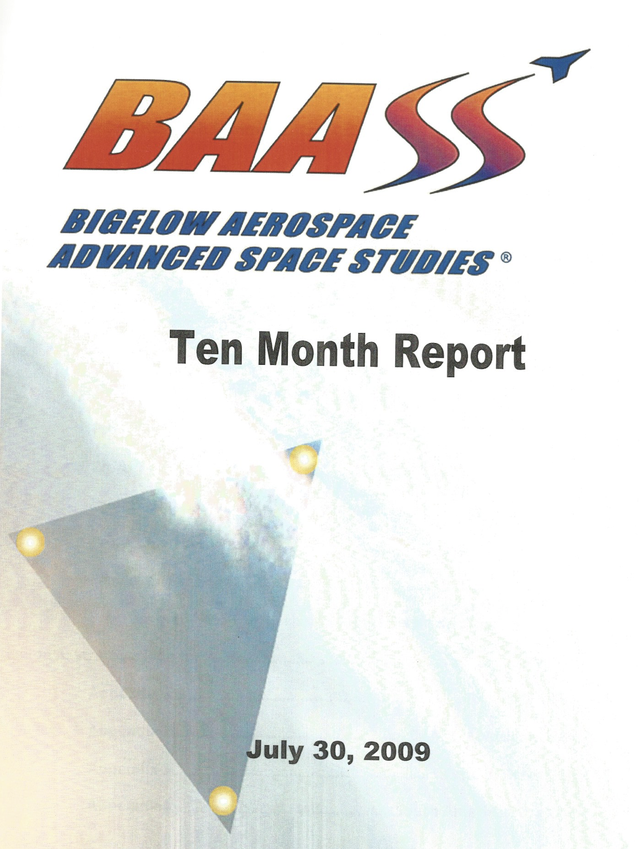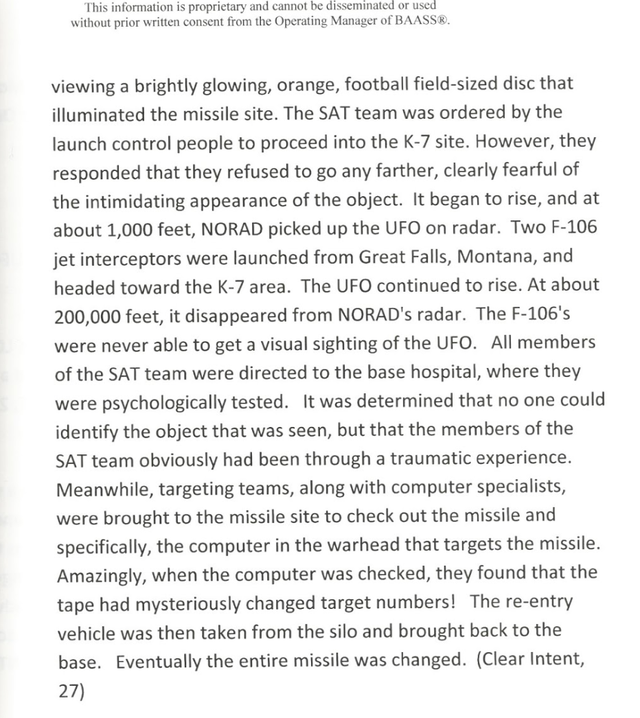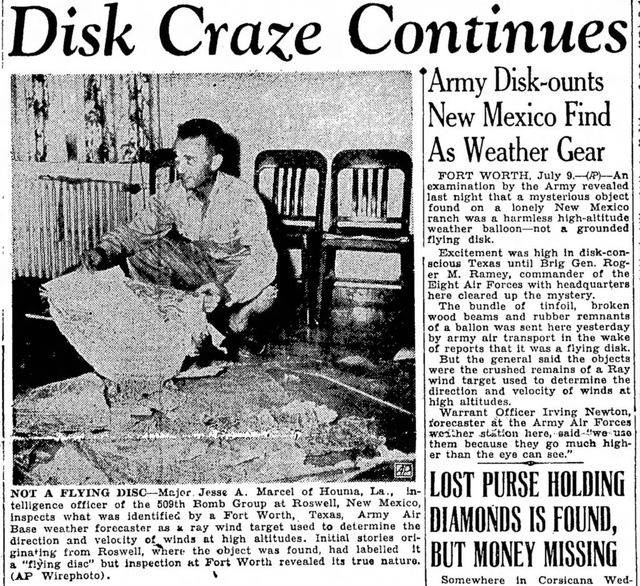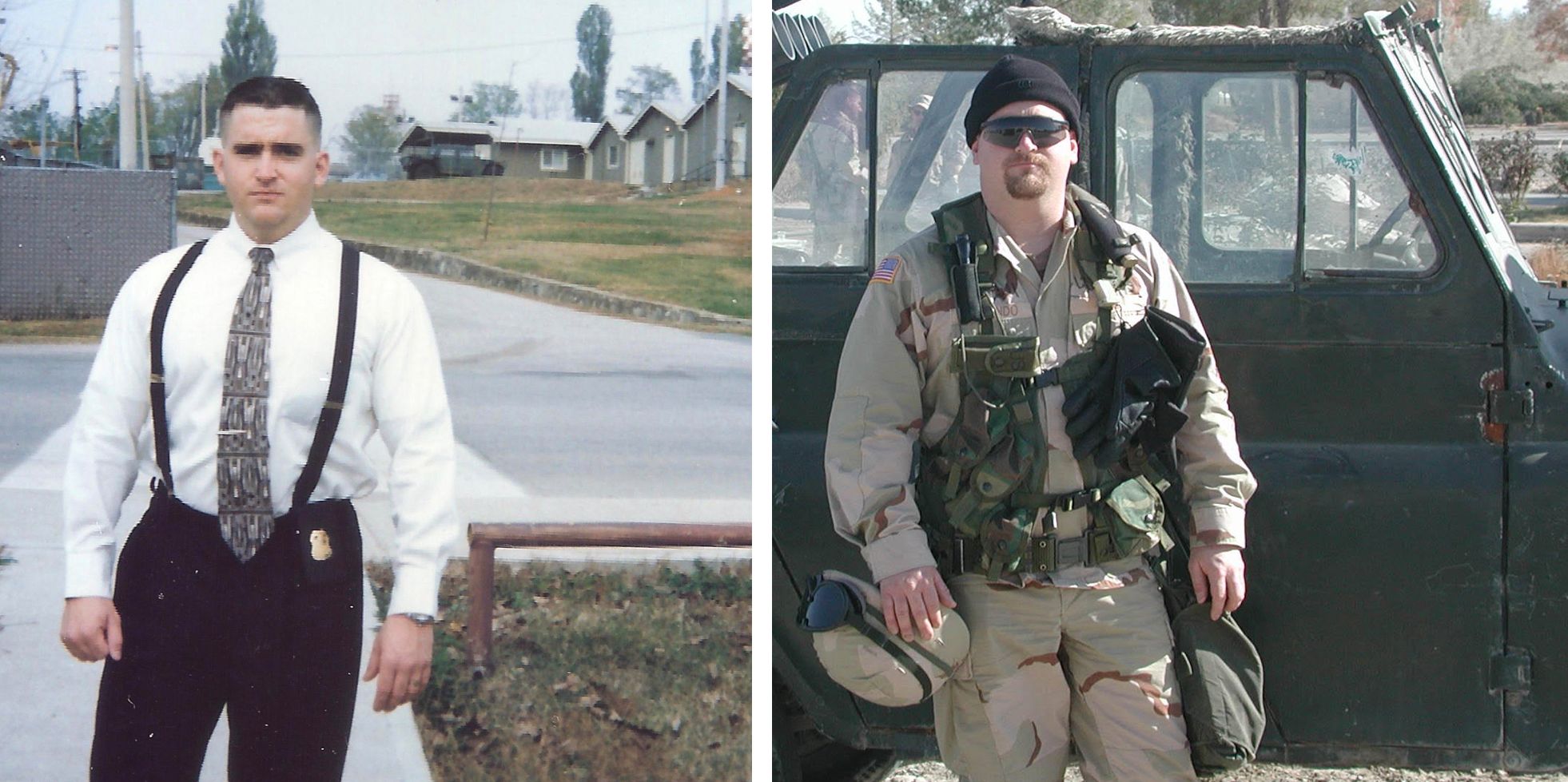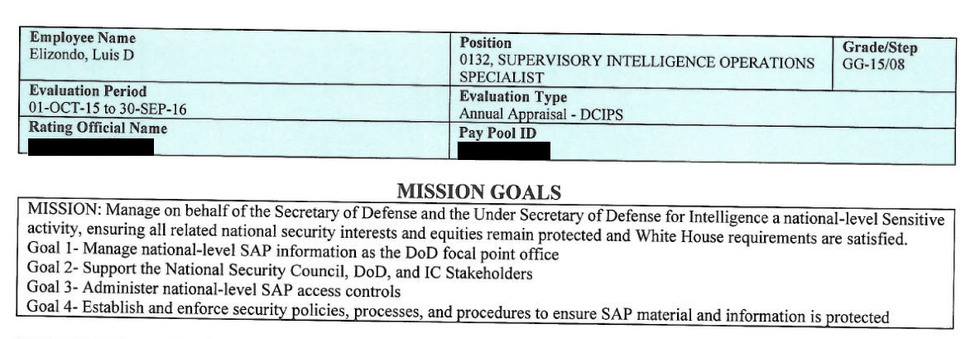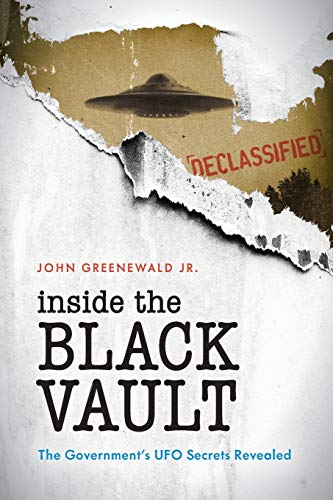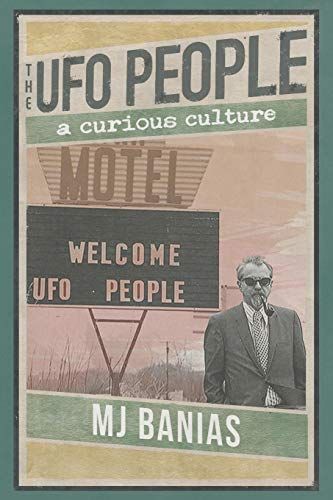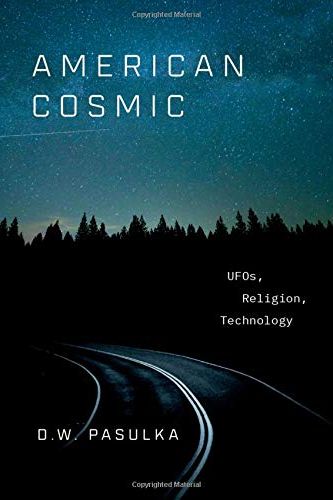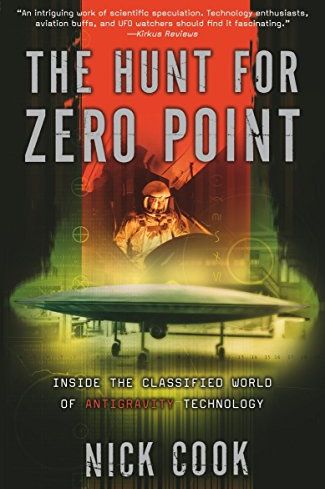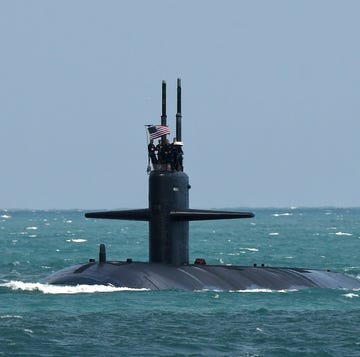The government can’t keep its story straight about its involvement with UFO research. After a yearlong investigation, we bust open the files, break through the noise, and reveal the definitive, staggering truth.
As I sit in a small cafe in the shadow of the ancient Roman gates in Trier, Germany, talking to a person whose credibility seems beyond reproach, but who will only agree to talk to me if provide absolute assurances of anonymity, I can’t help but feel like I’m trapped in a Dan Brown novel. The Da Vinci Code, however, never dealt with unidentified flying objects.
“Was it about UFOs? Of course,” this person whispers with a grin of melodrama.
After almost a year of investigating the U.S. government’s interest in UFOs, what they’ve just said should neither be shocking, nor revelatory. Unbeknownst to them, they’ve only further confirmed what over a dozen other people with backgrounds inside the government and the now-defunct Bigelow Aerospace Advanced Space Studies (BAASS) have already admitted to me.
Just like the fictional Robert Langdon, the path to understanding these mysterious government programs has taken me through the catacombs of informal secret societies, whose surprising memberships include accomplished professionals from the military, aerospace, academic, medical, and intelligence communities.
Though diverse or abstinent in how they define exactly what it all means, each of these enigmatic characters shares one common belief: unidentified flying objects are neither myth nor figment of overactive imaginations. With absolute conviction, they’ve all told me that UFOs are real.
Now, after two years of scant details and a myriad of contradictory statements, Popular Mechanics is ripping open the U.S. government’s massive UFO problem. What follows is a deep, unprecedented well of information that’s only been known by a very small select group of insiders—until now.
Part I. The Disclosure
On December 16, 2017, the New York Times disclosed that the Pentagon had secretly funded research into UFOs through the Advanced Aerospace Threat Identification Program, or AATIP. As if the U.S. government quietly investigating UFOs wasn’t enough, for the first time, the public also got a chance to see three videos captured by the U.S. Navy showing what has been claimed to be “Unidentified Aerial Phenomena,” or UAP.
In an instant, UFOs were no longer relegated to society’s nihilistically curious, and for the first time in decades, droves of the mainstream public suddenly found themselves peering skyward with wonder.
But almost as quickly as the excitement of mysterious black budget UFO programs crashed ashore, so, too, came vexing waves of criticism, confusion, and controversy.
From the onset, disarray and debate raged on whether the second “A” in AATIP officially stood for Aerospace or Aviation, with the former “Aerospace” eventually proving to be correct. Adding to the chaos, an entirely different program moniker emerged: the Advanced Aerospace Weapons Systems Applications Program, or AAWSAP. For over two years, no one has been able to adequately explain whether AAWSAP and AATIP were two separate programs, or the same intuitive under two separate names.
To muddle matters more, a revolving door of Pentagon spokespeople have successfully issued waves of contradictory statements about what the Department of Defense (DoD) did or didn’t do when it came to studying UFOs.
Initially, the Pentagon said, AATIP had indeed investigated UFOs under the leadership of Luis Elizondo, a former senior member of the Office of the Under Secretary of Defense for Intelligence (OUSDI). Eventually, in a complete reversal of official stances, the Pentagon’s newly crowned UFO point person, Senior Strategic Planner and Spokesperson Susan Gough, recently told The Black Vault, “neither AAWSAP nor AATIP were UAP related,” “Elizondo was not the director of AATIP,” and he didn’t have “assigned responsibilities” within the program.
In some consolation to the UFO faithful, the DoD has consistently been willing to say they consider the curious objects shown in the 2017 videos to be unexplained UAP. What exactly that means, however, has been open for interpretation and debate.
After months of conducting interviews and uncovering previously undisclosed materials, Popular Mechanics is revealing here that the U.S. government does indeed have a definite interest in UFOs.
Provided, of course, that nobody says it out loud.
Part II. The Seeds
The path to truly understanding the Pentagon’s current UFO problems doesn’t begin in 2008 with the Defense Intelligence Agency (DIA) and the AAWSAP, but rather, a decade earlier and some 2,000 miles from the nation’s capital at the doorstep of a billionaire Nevada entrepreneur.
Robert T. Bigelow, the owner of Budget Suites of America and founder of the space technology company Bigelow Aerospace, has never shied away from amplifying his interest in UFOs. In a 2017 interview, Bigelow told CBS’s 60 Minutes he was “absolutely convinced” aliens exist, before passionately declaring, “I don’t give a damn!” when asked if it was risky to publicly say he believes in UFOs and aliens.
In 1995, four years before founding his aerospace startup, Bigelow established the National Institute for Discovery Sciences (NIDS). From the company’s cached website, NIDS described itself as “a privately funded science institute engaged in research of aerial phenomena, animal mutilations, and other related anomalous phenomena.”
Before ultimately disbanding in 2004, NIDS conducted research into a host of various paranormal topics, such as cryptid encounters, cattle mutilations, and especially UFOs. The group’s most recognized research was the investigation of a purported paranormal Utah homestead owned by Bigelow called Skinwalker Ranch, which would later play a significant role in the DIA’s UFO interest.
In a 2018 interview with New York magazine, former Nevada Senator Harry Reid told an interesting tale about a curious letter Bigelow received from a senior official from a federal national-security agency. “I’m interested in talking to you, Mr. Bigelow. I have an interest in what you’ve been working on. I want to go to your ranch in Utah,” Reid recounted.
After vetting the letter’s author, the individual Reid described as a “very low-key scientist” was granted a pass to visit Bigelow’s ranch. In a lecture at “UFO MegaCon” in 2019, KLAS Las Vegas reporter George Knapp told the crowd these events occurred in 2007, and claims the person, described by Knapp as a “DIA scientist,” had an “experience” while visiting the supposed paranormal site.
In an interview with researcher Joe Murgia, former AAWSAP contractor and astrophysicist Eric Davis shared what colleagues had told him of the DIA scientist’s experience:
“In the living room of the former NIDS double wide observation trailer/staff quarters. A 3D object appeared in mid-air in front of him and changed shape like a changing topological figure. It went from pretzel-shaped to Möbius strip shaped. It was 3D and multi-colored. Then it disappeared.”
According to Reid, whatever happened at Skinwalker was enough to convince the DIA to seriously investigate paranormal and UFO phenomena. “‘Something should be done about this. Somebody should study it.’ I was convinced he was right,” Reid told New York.
In an interview with Popular Mechanics, Hal Puthoff, a former subcontractor for the AATIP, confirms the scientist’s visit, but was unsure how significant a role it played in the origins of AAWSAP.
“Reid is correct that early on there was a DIA scientist who expressed interest in hearing of the Skinwalker Ranch and did visit,” Puthoff says. “The degree to which this influenced initiation of the AAWSAP Program, however, or was just a side issue, I don’t know.”
While we don’t know how pivotal the Skinwalker visit was in the formation of the DIA’s UFO studies, we do know AAWSAP and AATIP were already taking shape almost a year before funding was established and the solicitation was issued.
Navy fighter pilot Cdr. David Fravor has arguably become the face of the famous UFO encounters by the Nimitz Strike Carrier Group, it was actually Marine Lt. Col. Douglas “Cheeks” Kurth who was first directed to investigate the strange airborne contacts that radar operators captured in November 2004.
On his LinkedIn profile, Kurth indicates he worked as a program manager for Bigelow Aerospace Advanced Space Studies, LLC (BAASS) until June 2013. Interestingly, Kurth began working for BAASS in December 2007—a month before Bigelow officially established his LLC in January 2008. That might be because Nevada state records show BAASS was technically a subsidiary of another business owned by Bigelow: International Space Hardware Services (ISHS). According to the Nevada Secretary of State’s Office, ISHS was incorporated on October 31, 2007.
Puthoff, who entered the BAASS fold in 2008, tells Popular Mechanics he was aware that Kurth was involved in the Nimitz events in 2004, but he didn’t believe BAASS specifically recruited Kurth because of it. “I think that it was just because of his experience he reached out to join [BAASS],” says Puthoff, who later founded and now runs the advanced concepts research institute Earthtech International.
Puthoff says he believes the DIA had expressed a need for what would become AAWSAP in 2007, but isn’t sure if the organization ever made a formal request. “I think that anything from 2007 was likely quite informal—discussions, letters, emails—but I’m not certain,” he says.
Regardless, roughly six months after BAASS opened up shop, with the support of late senators Ted Stevens and Daniel Inouye, Reid set up funding for AATIP and the AAWSAP contract in the Supplemental Appropriations Bill of July 2008. “It would be black money, we wouldn’t have a big debate on the Senate floor over it,” Reid told New York. “The purpose of it was to study aerial phenomena. The money was given, a directive was given to the Pentagon, to put this out to bid, which they did.”
On August 18, 2008, the contracting arm of the DIA issued a 32-page solicitation/contract/order for commercial items for the AAWSAP. When bidding closed three weeks later on September 5, as the sole bidder, BAASS was awarded $10 million dollars for the guaranteed first year, of a five-year option, for the contract.
On September 13, 2008, Bigelow Aerospace began listing career opportunities with BAASS in 14 different disciplines related to aerospace and research sciences.
Absent from the AAWSAP solicitation is any language related to UFOs or UAP. Instead, as originally outlined in the July Supplemental Appropriations Bill, the “primary focus is on breakthrough technologies and applications that create discontinuities in currently evolving technology trends. The focus is not on extrapolations of current aerospace technology.”
In past interviews, Reid has indicated the interested parties at the DIA felt it prudent to avoid any language that might cause someone to realize the underlying focus of the AATIP program was UFOs. According to Reid, a representative with the DIA told him, “What I will do is prepare something for you that anyone can look at it that wants to, it’s strictly science.”
On multiple occasions over the past two years, both the government and former contractors have used the terms AATIP and AAWSAP almost interchangeably. This has caused significant confusion of whether AATIP and AAWSAP were two separate programs, or the same activity under differing names. In a recent statement, Pentagon spokesperson Susan Gough told longtime researcher John Greenewald, “[AATIP] was the name of the overall program. [AAWSAP] was the name of the contract that DIA awarded for the production of technical reports under AATIP.”
While all sources associated with the programs confirm Gough’s statement with Popular Mechanics—AAWSAP was the contract component of the broader umbrella program dubbed ATTIP—they dismiss the latter sentiment expressed by Gough that “neither AATIP nor AAWSAP were UAP related.”
The evidence collected here overwhelmingly suggests the government was indeed studying UFOs and not, as the Pentagon has said, “investigating foreign advanced aerospace weapons system applications with future technology projections over the next 40 years, and to create a center of expertise on advanced aerospace technologies.”
Part III. The Report
In July 2009, BAASS provided a comprehensive report to the DIA at the conclusion of the first-year option of the AAWSAP contract. The 494-page “Ten Month Report,” as it’s called, is chock full of strategic plans, project summaries, data tables, charts, descriptions of biological field effects, physical characteristics, methods of detection, theoretical capabilities, witness interviews, photographs, and case synopses—each one entirely, explicitly about unexplained aerial phenomena.
Throughout the report, “the sponsor” is mentioned, however, the DIA is never explicitly named.
The first pages list the names of every contractor working for BAASS with appropriate security clearances to have access to the program. Amongst dozens of credentialed names, some of those listed are very familiar to the UFO community, including Puthoff, Davis, Jacques Vallee, and Colm Kelleher. Regardless of one’s existing opinions of the UFO phenomena, the sheer volume of content in the BAASS Ten Month Report is astounding.
Some of the notable content of the 2009 BAASS Ten Month Report includes:
● Overview of the BAASS Physics Division’s efforts to conduct research on advanced aerospace vehicles, including the development of standardization for measurement of physical effects and signatures associated with UAP.
● Overview of BAASS research for measuring and gleaning the effects on biological organisms from UAP.
● Mention of Skinwalker Ranch in Utah as a “possible laboratory for studying other intelligences and possible interdimensional phenomena.”
● Strategic plans to organize a series of intellectual debate forums targeted to broad audiences pertaining to the “potential disclosure of an extraterrestrial presence.”
● Plans to create a “medical physiological UAP effects program.”
● Request for Project Blue Book files that have not been made public.
● Mention of BAASS program dubbed “Project Northern Tier,” which involved securing documents related to instances where dozens of UFOs flew over restricted airspaces of facilities housing nuclear weapons.
● A possible UAP landing reported to BAASS by the Mutual UFO Network (MUFON) and its STAR Team (rapid response field investigators funded by BAASS in March 2009).
● Project databases of UAP-related materials compiled through various partnerships, and the intent to expand these databases by coordinating with foreign governments.
● Summaries of multiple UAP events both inside the U.S. and in foreign countries.
● Photographs of UAPs provided by various sources, including foreign governments.
From cover to cover, the BAASS report references the government’s new buzzword for UFOs: UAP. However, nowhere could Popular Mechanics find a single reference to foreign (terrestrial) advanced aerospace weapon systems, or projected technological innovations based on current industry trends.
Sources tell Popular Mechanics the BAASS Ten Month report was only a sample of the materials the organization provided to the DIA. “Monthly reports were being sent to the Pentagon, in addition to annual program updates, that were all about UAP or anomalous phenomena,” says one former BAASS contractor.
Chris Bartel, a security officer and investigator for BAASS (later Bigelow Aerospace) from 2010 to 2018, confirms the accounts of former BAASS and AATIP employees with Popular Mechanics. He says he indeed encountered some fairly dramatic paranormal events while working at the Skinwalker Ranch, and says he’d also heard mumblings of BAASS being interested in studying paranormal activity in hopes it could lead to technology research. However, Bartel says he didn’t know anything about AAWSAP or AATIP until last fall. “I was a bit taken back, to say the least,” he says.
Though unaware of any formal contract with the DIA, Bartel confirms that reports generated about paranormal events on the ranch were being faxed to both Bigelow and the Pentagon on a regular basis. (“I would hate to think my experiences up there were somehow manipulated by outside man-made forces,” Bartel says. “I truly believe the ranch to be hallowed Native land.”)
Some have suggested the “paranormal” events associated with Skinwalker Ranch or AAWSAP could be associated with secret and highly advanced weapons testing. While Bartel says it’s possible weapons were being tested, nothing he observed was consistent with his experiences of top secret testing.
Puthoff also says he saw no evidence that BAASS was involved in weapons testing during his tenure with the organization—“a statement I’m certain Mr. Bigelow would support,” he says. (Bigelow could not be reached for comment.)
Part IV. The Secrets
The revelations in the BAASS report beg the question: Why is the government now insistent it never studied UFOs, and why aren’t these documents being discussed or made available through Freedom of Information Act (FOIA) requests?
Individuals who worked on the AATIP program say the current uncertainty and confusion was by design and involved a dizzying shell game that’s entirely consistent with how black budget intelligence programs are run. “What you’re dealing with is the very core of government secrecy and how things they absolutely don’t ever want to discuss are kept hidden away,” one former AATIP contractor tells Popular Mechanics.
Sources say the key to understanding current denials of UFO studies in AATIP comes from a phrase stamped on each page of the BAASS Ten Month Report obtained by Popular Mechanics:
“The information is proprietary and cannot be disseminated or used without prior written consent from the Operating Manager of BAASS.”
According to several former AATIP contractors, the “product” being produced for the DIA was technical reports on exotic and potential “game-changing” aerospace technologies, and the manner of determining what areas these radical airborne breakthroughs might emerge was through the research of UFOs.
In exchange, not only would the DIA get the agreed-upon technical reports, but it would also gain access to the extensive research BAASS was gathering on UFOs. While the DIA had access to the volumes of UFO data, the materials were actually commercial property of BAASS, as a subsidiary of Bigelow Aerospace.
The idea of using an aerospace research project as a cover for a secret UFO program may seem unscrupulous. “But this all rings very familiar,” Neil Gordon, an investigator with the Project on Government Oversight, tells Popular Mechanics.
Gordon, whose area of expertise is in federal contractor misconduct, contractor accountability, and government privatization, says running the “commercial in confidence” program through AATIP is consistent with how the DoD deals with programs it wants to keep secret. “Whether it’s right or not is another story,” Gordon says, “but everything sounds very common for how black budget programs run.”
The DIA may have had extensive access to the UFO materials, but because all of the data technically belonged to BAASS, under the Economic Espionage Act of 1996, disclosing or releasing proprietary materials provided to the government in confidence is a federal crime. Essentially, the DIA’s UFO program was set up to circumvent FOIA requests and avoid having to discuss UFOs publicly.
Out of concern for providing Popular Mechanics access to the 2009 BAASS Ten Month Report, the person who made these materials available did so only under the guarantee of anonymity. It’s worth noting this person is not a current government employee, nor were they involved with BAASS or the AAWSAP contract.
“Unfortunately, the government attempting to evade FOIA by contracting out its responsibilities is nothing new,” Josh Burday, an attorney who specializes in FOIA and First Amendment cases, tells Popular Mechanics. “Both federal and state FOIA statutes strive to eliminate such obvious gamesmanship—avoiding transparency and disclosure obligations by contracting out functions—but whether they are successful in doing so is an entirely different story.”
Davis, the astrophysicist and former AAWSAP contractor, says his work on the AATIP program was entirely consistent with all of the technological intelligence programs he’d previously worked on over the last 30-plus years. “Indeed, science is applied, but right now there’s not enough data on UAP to make examining it a scientific endeavor. It’s an intelligence issue, not a scientific endeavor,” he says.
Puthoff, meanwhile, says BAASS produced “stacks of material to the ceiling,” but because of the way things were done, he was surprised to hear any of it had become public. “To be honest, I didn’t think this stuff would ever see the light of day,” he says.
When reached for comment, Colm Kelleher, the former Deputy Director of BAASS, said, “I am unable to discuss this topic.” Multiple other requests to Bigelow Aerospace for comment went unanswered.
The entire manner in which the DIA partnership allegedly operated raises an important question: Could the reason for the Pentagon’s recent denials of AATIP or AAWSAP conducting UFO research be the result of the current DoD administration being naive to the program’s underlying and commercially secret hidden purpose? It seems like a plausible theory … if it wasn’t for something else Popular Mechanics uncovered.
Part V. The Admission
Last year, Steven Aftergood of the Federation of American Scientists obtained via FOIA request and published a January 2018 letter that the DIA Congressional Relations Division sent to members of Congress. In the letter, the DIA provided “a list of all products produced under the AATIP contract for the DIA to publish.” The referenced list includes 38 technical papers, called Defense Intelligence Reference Documents (DIRDs), which cover a range of advanced, exotic, and theoretical aerospace topics.
Given what’s been said about the commercially confidential nature of AATIP, the phrase “for the DIA to publish” may be a critical play on words. Nevertheless, a source with access to the materials provided Popular Mechanics with a copy of a previously unreleased technical paper listed as one of AATIP’s products.
While the DIA refers to the paper as “Field Effects on Biological Tissue,” the original title for the submitted paper appears to actually have been “Clinical Medical Acute & Subacute Field Effects on Human Dermal & Neurological Tissues.” According to the study’s introduction, the paper is an examination of “clinical medical signs and symptoms and biophysics of injury known and expected from near-field (mostly ultra-high), NIEMR Microwave, Thermal, from unintended exposure to anomalous systems.”
You can read the entire study below.
In light of the cumbersome clinical language, just a cursory scan reveals the entire focus was on examining injuries that may have occurred after contact with UFOs or UAP. In fact, the very term “UFO” appears 16 times in the report; the word “anomalous” is used 27 times (most often with the word “aircraft,” “aviation,” or “aerospace” immediately following); and the phrase “Advanced Aerospace Systems Applications Program” is mentioned in bold on four occasions.
Popular Mechanics spoke with the study’s author, Christopher “Kit” Green, a forensic clinician and neuroscientist. Green was surprised to learn his research paper had become publicly known, because he was under the impression it was never included in the distributed set, nor was it finally peer-reviewed.
Green confirms his paper wasn’t cited correctly in the letter to Congress, however, he says the 54-page document Popular Mechanics obtained appeared to be the same paper he was requested to provide as a product of AAWSAP.
“This focused on forensically assessing accounts of injuries that could have resulted from claimed encounters with UAP,” says Green. “I didn’t work for BAASS, other than as a contractor for my paper, and I wasn’t a part of AAWSAP. However, it is my understanding this program was a UFO study that outwardly was not supposed to look like it had anything to do with UFOs.”
Green cautions some past speculations about his paper were inaccurate, including the claims it was an effort to understand or reverse-engineer UAP technology. Green also stresses that while his work focused on encounters with unknown or unidentified aerial objects, all of the injuries he assessed could be accounted for by known terrestrial means, and did not provide any evidence for extraterrestrial or non-human technologies.
Could the 38 technical reports BAASS produced for AATIP represent what it determined accounted for UAP?
“Many of the topics could be called ‘dual-use’ given that, say, papers on advanced plasma propulsion and invisibility cloaking could apply to our own advanced aerospace development as well as possibly some UAPs,” says Puthoff. But his “spacetime metric engineering paper, the warp drive and wormhole papers, and specifically the Statistical Drake Equation paper are essentially applicable only to UAPs.”
A Timeline of UFO Programs
Davis, who worked with Puthoff and authored four of the DIRDs, offers a particularly intriguing detail about the DIA’s 38 reference papers.
“This wasn’t focused on whether or not [UAP] are real. It’s already been well established that UAP are real by a preponderance of evidence. Some classified and some proprietary [that] I can’t talk about,” he says.
Instead of investigating if UAP are real, the 38 technical papers for the AAWSAP contract were also an intelligence assessment to measure just how far advanced UAP could be from current and projected scientific understandings. “Me, Hal [Puthoff], and an aerospace executive who had access to materials worked on that assessment for the DIA,” Davis says.
Ultimately, aside from the wealth of BAASS proprietary evidence, Green’s study alone—which the DIA told Congress was a product of AATIP that it would “be happy to provide upon direct request”—seems to completely dispute the Pentagon’s recent claims that neither AATIP or AAWSAP were related to UFOs.
In an exchange of emails between Gough, the Pentagon spokesperson, and Swedish research Roger Glassal, which were provided and published by research analyst Keith Basterfield, Gough said AAWSAP commenced in the fiscal year (FY) 2008 with a designated $10 million dollars of funding. Since the bid solicitation wasn’t issued until August 2008, we now know that Gough was mistaken, and the program actually began in FY2009, which began October 1, 2008.
In the same email exchange, Gough indicated the first 26 technical reports were completed in late 2009 and an additional $12 million dollars was designated in the FY2010 Defense Appropriations Act for 12 additional reports. (Editor’s note: In the original email, Gough indicated “late 2008.” It’s assumed this was also said in error since BAASS didn’t receive the AAWSAP contract until September 2008 and Green’s technical paper is dated May 2009.)
“After an OSD/DIA review in late 2009, it was determined the reports were of limited value to DIA and there was a recommendation that upon completion of the contract the project could be transited to an agency or component better suited to oversee it.
Funding for the program at the DIA ended in 2012 and DoD elected not to continue the program after the work contracted under the FY2010 NDAA was completed.”
Indeed, every source Popular Mechanics spoke to for this story agrees the partnership between BAASS and AAWSAP had concluded by 2012.
But here’s where things get messy: Gough says when DIA funding dried up in 2012, the overarching AATIP program closed up shop as well. Every source we spoke to, however, says not only did AATIP not end in 2012, but the program is still ongoing to this day.
Core to the contention of whether or not the government maintained an interest after 2012 is the man the DoD says “had no responsibilities” with AAWSAP or AATIP: former senior Pentagon intelligence executive Luis Elizondo.
Who, exactly, is Elizondo? A patriotic whistleblower putting his reputation at stake for something he says the American public must know about? Or a huckster using his former position for his own benefit, as the Pentagon seemingly implies?
Part VI. The Leader
After serving a stint as a counterintelligence agent for the U.S. Army, in the late 1990s, Elizondo would be recruited into the ranks of the enigmatic U.S. intelligence community.
Elizondo’s first stop as an intelligence operations specialist was running counterinsurgency and counternarcotics operations in Latin America. “We dealt with a lot of stuff, like coup d’etats, black market terrorism, violent drug cartels, all that kind of stuff,” Elizondo says.
Following the attacks of September 11, 2001, Elizondo was then redirected toward East Asia, where he served an advisor of a small intelligence unit assigned to support General James Mattis during his command of Marine Expeditionary Unit (MEU) Task Force 58 (TF-58) in the War on Terrorism. In a case study published by the Naval War College in 2016, Lt. Col. Damian Spooner describes the analysis and products produced by intelligence sections under Gen. Mattis as being “indispensable” in driving TF-58 planning and operations.
Later, while continuing to support the U.S.-led war on terrorism, Elizondo, the son of a Cuban exile, found himself in Cuba dealing with some of the most dangerous terrorists in the world at Guantanamo Bay’s infamous “Camp Seven,” the prison constructed for the sole purpose of housing 14 “high-value detainees.”
In early 2008, James Clapper, then the Deputy Secretary of Defense for Intelligence, asked Elizondo to come to the Pentagon to help coordinate information sharing and partnership engagement being run by the Secretary of Defense’s Office. Though the promise of cutting his daily commute in half was one of the biggest selling points, Elizondo’s decision to set up shop at the Pentagon would end up putting him directly in the path of recruitment for a special program the DIA had just started running: AAWSAP.
Though the BAASS Ten Month Report includes an abundance of UAP information, nothing within the text contains any data or information provided by the U.S. government. Conversely, there are a number of requests made by BAASS for access to specific UAP information being held within the DoD and other U.S. agencies. Sources say this is key to understanding how Elizondo entered the picture.
“If they [BAASS] wanted access to info that I’m not saying does exist, but it might have been highly classified, you need someone who had the tickets to make sure the contractors weren’t actually looking at Special Access Program (SAP) stuff thinking it was UFOs,” says an intelligence official who is not authorized to speak on the record.
“Plus,” the official tells Popular Mechanics, “I’m not saying it was, but they might have been looking into something that was of significant interest to foreign advisories and a high-value target for espionage. Bottom line, you needed a counterintel guy.”
Elizondo tells Popular Mechanics that he never wanted to be a part of AATIP. However, as a senior official at OUSDI with a background in counterintelligence, he found himself being recruited into the ongoing UFO effort.
“In 2008,” Elizondo says, “two guys came by my office and said, ‘Are you Lue Elizondo?’ The first thing I thought was, ‘Oh no, what did I do?’ They told me, ‘You came highly recommended as a former senior CI guy with some background in advanced avionics.’ Which is true—I worked some on the Open Skies Treaty. I worked with Raytheon, Boeing, and some other stuff. That was my portfolio.”
Elizondo was told AATIP needed a counterintelligence support and security guy for a very special program. Within a month, after a series of meetings, Elizondo finally met with the then-director of AATIP, who asked him what seemed like a strange question at the time:
“What do you think about UFOs?”
Elizondo was flummoxed. “I was like, ‘What the hell?’ I thought it was a test or something. So I told the truth: I don’t. I don’t think about UFOs. I don’t know if they’re real or not. I don’t think about them. I’m too busy trying to catch terrorists and bad guys.”
Elizondo’s ambivalence was evidently exactly what those running the program wanted to hear. Soon enough, Elizondo joined AATIP. “Seriously, for awhile, I still didn’t know if it was a test,” he says. “It wasn’t until I started examining the security posture of the portfolio that I suddenly realized these things are really unidentified.”
Not long after Elizondo was on board, in June 2009, Sen. Harry Reid submitted a letter to then-Deputy Secretary of Defense William Lynn III requesting AATIP be granted restricted SAP status. Though ultimately denied, had Reid’s request been granted, it would have further tightened security and secrecy around AATIP.
Last year, KLAS Las Vegas reporter George Knapp published Reid’s letter showing Elizondo’s name on the list of “preliminary government personnel” who would have had access to AATIP. In addition to Elizondo, Reid, and the late Senator Daniel Inouye, seven other names of government employees (which have not been released) would have had access to the proposed AATIP SAP. Notably, only three “contractor personnel” made the cut.
According to a source with knowledge of the letter, the three contractor personnel Reid wanted to grant preliminary access to were Bigelow, Kelleher, and Puthoff. Puthoff confirms with Popular Mechanics that he was one of the three approved contractors on the list. The Pentagon later confirmed the letter published by Knapp was authentic.
Sources say the limited number of contractors listed with access is yet another breadcrumb left on the trail of secrecy showing AATIP was indeed slightly different from the AAWSAP contract.
According to multiple sources, including individuals working within the Pentagon—and confirmed by Elizondo—in 2010, when the DIA cut off funding for AATIP’s contract, a DIA program manager asked Elizondo if he would keep the UFO project running. “I wasn’t a DIA employee,” Elizondo says, “so I’d have to run it wearing my OSD hat at the Pentagon. We all agreed this was the best thing to do, so that’s what we did.”
By all accounts, Elizondo was now “bootstrapping” AATIP from the OUSDI, meaning he added the program to the list of his existing intelligence portfolios.
Popular Mechanics has learned the post-BAASS era of AATIP was an even more closely guarded program and consistent with how highly classified intelligence projects are conducted.
“Ninety percent of people don’t understand how the general government runs, and even less understand the intelligence community,” a former senior Special Operations and Intelligence Officer tells Popular Mechanics. “Because this program would have now been out of the Front Office, your guy [Elizondo] would have had the ability to muster up people from various areas of the Intelligence Community. You would have wanted to include the least possible, but best people for the specific mission. You could have had people from the DIA, ONI [Office of Naval Intelligence], and OSI [Office of Special Investigations] all working separately, but together on the same mission.”
Elizondo says when he took over the AATIP, he ran it like a traditional government effort. “We greatly reduced the number of contractors to just what we might have needed, but this was going to be government to government, looking on government systems at government data,” he says.
According to Elizondo, unlike most of the BAASS personnel, the post-2012 AATIP crew did have access to highly classified government information to adequately assess the situation. While the Pentagon denies that AATIP continued after 2012, Elizondo says the post-BAASS AATIP was not unsanctioned, and not just a group of government UFO enthusiasts. “Very, very few people in the building knew what we were doing, but the Front Office (Office of the Secretary of Defense) was in the loop,” he says.
Popular Mechanics has learned the ONI was one of the major backers that wanted to see AATIP continued, which sources say is why the Navy has been so willing to take the most public lead on the UAP issue today.
Elizondo’s critics have repeatedly asked an important question: If AATIP was such a secret program, why is Elizondo now talking about it publicly?
By denying AATIP SAP status back in 2009 and not ever officially blanketing it under a security classification, Popular Mechanics has learned that the government effectively allowed for the program itself to now be discussed.
“There’s a lot they can’t talk about, like sources, methods, etc., but the program itself is unclassified and fair game for public disclosure,” a source with knowledge of the program tells Popular Mechanics. Elizondo confirms this is correct. “I’ve never once violated, nor am I willing to violate my security oaths, so anything I’ve discussed is indeed unclassified,” he says.
In one of Elizondo’s employee performance evaluations, which Popular Mechanics obtained, it lists his primary “mission goals” as managing and administering information, access controls, and security of national-level SAPs for the Secretary of Defense. Elizondo confirms his position allowed him access to the most highly secretive and reclusive programs being run by the U.S. “The stuff we were seeing was truly unidentified. It wasn’t related to anything we were doing,” he says.
In October 2017, Elizondo resigned from the DoD to join former Blink-182 frontman Tom DeLonge’s UFO research group To the Stars Academy of Arts & Science, which would soon release the Navy’s “Flir1” video to the world and properly kick off a ufological renaissance. Elizondo now works as the company’s Director of Global Security and Special Programs.
Why did Elizondo leave his government job? Because he realized the Pentagon’s top brass would never treat UAP with the importance they deserved. A senior Pentagon official tells Popular Mechanics they were aware that Elizondo briefed a White House intelligence aide and two senior aides to Mattis, then the Secretary of Defense, in the spring of 2017.
The official, who is not authorized to speak on the record, says the White House aide was uncomfortable with the prospect of UFOs being real. To their knowledge, the White House aide did not pass the information along. The aides to Mattis, meanwhile, acknowledged UFOs were a real issue, but they were concerned with the political optics should it ever come out that the Secretary of Defense had been briefed about them. Elizondo confirms the accuracy of these accounts. “I resigned only after multiple attempts to brief the Secretary [of Defense] failed,” he previously told Popular Mechanics.
Finally, while the Pentagon has denied AATIP’s existence after 2012 and that Elizondo was never involved in looking into UFOs, Popular Mechanics has obtained documentation that seems to unambiguously show AATIP was active after the closing of the BAASS AAWSAP contract, Elizondo was running this extension of AATIP, and the efforts to examine UFOs are still currently underway.
Though the documents were unclassified, they contained sensitive information, and the person sharing them did so only under the guarantee that Popular Mechanics would not make them publicly available. The person said they only were willing to share the materials to support Elizondo’s claims, which they say have been unfairly challenged over the last two years. The individual, who is not a government employee, did approve the release of a small section from one of the documents showing the changing of responsibilities before Elizondo left the DoD.
Part VII. The Unknown
In June 2019, the Office of Sen. Mark Warner (D-Va.), vice chairman of the Senate Intelligence Committee’s office, confirmed that closed door meetings on UAP have occured. More recently, last December, when asked by Conway Daily Sun reporter Daymond Steer about the Navy UAP encounters, recent presidential candidate and current member of the Senate Select Committee on Intelligence, Sen. Michael Bennet, was cautious in saying he wouldn’t share anything he’d learned on the Intelligence Committee. However, Bennet said, “Our guys are seeing stuff that’s unidentified. They don’t know what it is, I don’t know what it is … We’re trying to learn more about it. The Air Force is trying to learn more about it.”
Popular Mechanics has since learned in October 2019, staffers with the Senate Select Committee on Intelligence and the Senate Armed Service Committee were briefed on current UAP issues. According to people with knowledge of these briefings, some former BAASS contractors and current AATIP leadership were in attendance.
Insiders also say this past year, during a closed-door meeting with the Senate Intelligence Committee, Brigadier General Richard Stapp, Director of the DoD Special Access Program Central Office, testified the mysterious objects being encountered by the military were not related to secret U.S. technology. The Pentagon did not respond to requests by Popular Mechanics to confirm Stapp’s testimony before the Intelligence Committee.
In only the second time publicly discussing the event, Popular Mechanics spoke with the Navy fighter pilot who was Cdr. David Fravor’s wingman during the now-famous 2004 Nimitz UFO encounter. Agreeing to talk only under the condition of anonymity, the fighter pilot confirmed they testified in front of congressional leadership about their encounter. “I’ve been requested repeatedly to go to the Pentagon and asked, ‘Is this what you saw?’.”
During a series of email exchanges, Popular Mechanics provided specific information to Gough, the Pentagon spokesperson, in an effort to see if this might influence the DoD’s current position. Initially, Gough said she would examine the information and see if she could provide a statement in response. However, Gough has not responded to repeated follow-up requests from Popular Mechanics.
On its own, the evidence showing the Pentagon is interested in UFOs is unlikely to change the minds of many who are skeptical of the idea that mysterious, apparently intelligent, and possibly otherworldly objects might be buzzing around the skies above Earth.
“The whole contracting process for this program was irregular from start to finish,” Steven Aftergood, Director for the Federation of American Scientists Project on Government Secrecy, tells Popular Mechanics. “[The AAWSAP contract] sounds like it was a good deal for the contractor. But it would be hard to argue that either the military or the public got their money’s worth.”
Meanwhile, William Culbreth, an engineering professor at the University of Nevada Las Vegas who authored two of the 38 technical papers provided in the AAWSAP contract, offers a different opinion. He says he was unaware of the UFO background of AAWSAP, but very familiar with BAASS’s UFO interest.
“I had some graduate students who worked for BAASS during that time and I know Bigelow has an interest in the topic, but no one mentioned anything about UFOs when they asked me to write the papers,” Culbreth says.
Regardless of where the underlying motivation may have come from, Culbreth says his work on the two papers—“Detection and High Resolution Tracking of Vehicles at Hypersonic Velocities” and “Aneutronic Fusion Propulsion II”—led to his examination of new approaches to nuclear propulsion technology, which might not have been inspired otherwise.
“We’re looking into these propulsion technologies today, and this area alone led to several of my students pursuing PhDs who I don’t think otherwise would have,” Culbreth says.
With the wealth of data collected by BAASS, and almost assuredly more information being gathered by AATIP, it raises the question: Is the UAP issue being closely guarded because we don’t believe it’s real, or because we’re afraid we can’t understand it?
Mick West, the author of Escaping the Rabbit Hole: How to Debunk Conspiracy Theories Using Facts, Logic, and Respect, suggests the public availability and confirmation of rigorous empirical studies by AATIP could change the entire UFO dynamic. “It would be fantastic if there was some good evidence of something new to science. So far there isn’t,” he tells Popular Mechanics.
While he faces considerable angst for trying to debunk UFOs, West says he’d be as thrilled as anyone else if he was able to actually come across something that was truly unexplainable and unknown. “There’s no hard feelings,” he says. “I understand people are passionate—especially experiencers.”
So was this a matter of the government discovering something it didn’t understand, and therefore opting to avoid it altogether? Nick Cook, the former aviation editor of Jane’s Defense Weekly and author of The Grid, tells Popular Mechanics this idea reminds him of a conversation he had with Ben Rich, the former director of Lockheed Skunkworks and the “father of stealth.”
Cook says Rich told him when the ability for stealth aircraft was discovered, but not yet understood, there was considerable debate on what to do next. “Do you put a bunch of money into developing something and end up not being successful because you don’t understand it, or do you table the entire idea until you have more science, which runs the risk of someone else figuring it out first?”
With stealth technology, the U.S. military ultimately made the decision to move forward, which led to the development of the world’s first stealth aircraft, the F-117 Nighthawk. “I guess it would depend on how wide a knowledge gap you thought there was and how high was the risk for success,” Cook says. “Could I see how something could come up, and the decision would be made to tuck something away like the final scene of Raiders of the Lost Ark? Yes, I could see how it could be possible.”
“Throughout history, many inventions have preceded an understanding of the science that makes them work,” Matthew Hersch, a history of science and technology professor at Harvard University, tells Popular Mechanics. “Engineers often ‘do science’ in the course of their work, just as scientists ‘invent.’ It’s inevitable that we as a species will continue inventing things without a real understanding of how they work, at least until our science catches up.”
Being unable to explain something with current science, Hersch says, is merely an invitation to do more science—not a rejection of the scientific worldview as a whole. “Suppressing good, non-fraudulent science because it challenges our beliefs is extremely dangerous,” he says. “Nobody has a right to do that, and it is contrary to the interests of humanity—that’s what science is for. Fortunately, there is no vast scientific conspiracy to suppress divergent ideas. More often, good science is suppressed by non-scientists for political reasons.”
Any discovery of extraterrestrial science or technology, then, is no reason to flush our political norms down the toilet, says Hersch.
“Human beings have believed in the existence of extraterrestrial life for millennia,” he says. “I suspect that any revelation that [UFOs] exist would be met with something close to a shrug.”
Tim McMillan is a retired police Lieutenant and intelligence analyst from Savannah, Georgia. To satisfy his love for solving mysteries, Tim now works as an investigative journalist—examining any question worth answering.






